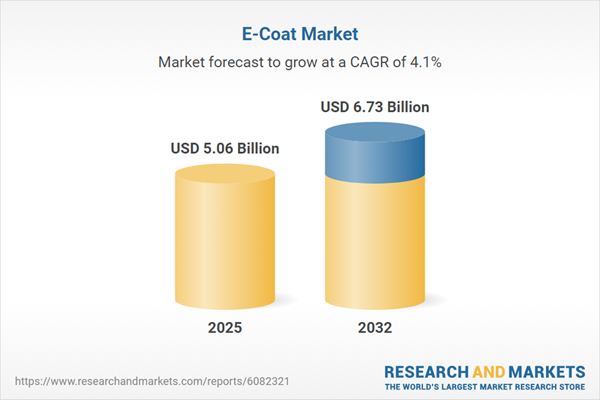Speak directly to the analyst to clarify any post sales queries you may have.
The E-Coat market is experiencing transformation as new technologies, stricter regulations, and sustainability demands reshape industry standards. Senior executives must prioritize adaptability, compliance, and innovation to secure a competitive edge.
Market Snapshot: E-Coat Market Growth Trajectory
The global E-Coat Market expanded from USD 4.86 billion in 2024 to USD 5.06 billion in 2025, and is forecast to reach USD 6.73 billion by 2032 at a CAGR of 4.13%. Growth stems from robust adoption in automotive, appliances, and industrial equipment sectors. Operators in these industries focus on optimizing corrosion resistance and process efficiency through electrocoating. The changing procurement environment, driven by expanded sustainability targets and evolving regulatory demands, underscores the importance of future-ready supply chains. Companies are recalibrating strategies to account for environmental policies that influence investment and purchasing choices across the value chain.
Scope & Segmentation
- Electrodeposition Types: The report analyzes both anodic and cathodic methods, each offering distinct corrosion protection and finish characteristics for diverse industrial and high-performance settings.
- Substrate Materials: Assessed substrate types include aluminum, cast iron, and steel, with a focus on differing adhesion requirements and specialized pre-treatment protocols to fit sector needs.
- End Use Industries: The study includes major application segments such as automotive—which comprises both commercial and passenger vehicles—and appliances, encompassing small devices and white goods, each subject to unique durability and compliance benchmarks.
- Geographies Covered: Regional analysis spans North and South America, Europe, Middle East & Africa, as well as Asia-Pacific, offering insights into market dynamics, adoption drivers, and local regulatory influences relevant to executives with cross-border operations or growth plans.
- Company Coverage: In-depth profiles feature industry leaders like PPG Industries, The Sherwin-Williams Company, Akzo Nobel, Nippon Paint Holdings, Axalta Coating Systems, BASF, Kansai Paint, RPM International, Henkel AG & Co. KGaA, and Jotun A/S, outlining strategies in innovation, alliances, and product pipelines pertinent to competitive positioning.
Key Takeaways for Senior Decision-Makers
- Environmental regulations increasingly favor low-emission, waterborne options, compelling companies to align production and sourcing with green compliance initiatives.
- Integration of digital tools supports real-time monitoring and predictive maintenance, advancing consistency in output and reducing operational inefficiencies.
- Collaborations between raw material suppliers and OEMs accelerate the introduction of innovative formulations, especially where performance and lifecycle benchmarks carry strategic weight.
- Supply chain strategies are evolving toward flexible, locally sourced models as organizations mitigate the impact of disrupted trade and prioritize regional resilience.
- Variation in regulatory oversight and infrastructure access across global regions requires executives to tailor deployment and go-to-market strategies for optimal uptake.
Evaluating Tariff Impacts and Strategic Responses
Emerging tariffs in key markets such as the United States compel industry leaders to revisit E-Coat supply chain models and procurement approaches. Many organizations reinforce regional production, expand partnerships with domestic entities, and refine inventory processes to manage rising costs. Smaller firms in the value chain focus on collaboration or consider market consolidation to withstand economic pressure. Prioritizing regional sourcing and targeted investment in plant capacity empowers players to proactively navigate evolving trade hurdles and regulatory uncertainty.
Methodology & Data Sources
This report combines data from industry databases, regulatory documents, and patent filings with direct interviews from formulators, equipment manufacturers, and procurement teams. Triangulation and rigorous quality checks support robust, actionable insights throughout the research process.
E-Coat Market: Why This Report Matters
- Helps decision-makers formulate targeted entry or expansion strategies by providing region- and segment-specific analysis tailored to executive priorities.
- Provides leadership teams with actionable intelligence on technology shifts and regulatory standards impacting operational competitiveness and long-term growth.
- Supports risk mitigation by detailing procurement and supply chain approaches responding to ongoing trade and policy changes.
Conclusion
Senior executives navigating the E-Coat market must balance innovation, sustainability, and operational agility. Leveraging focused strategic insights will drive informed decision-making and resilience as the sector continues to evolve.
Table of Contents
3. Executive Summary
4. Market Overview
7. Cumulative Impact of Artificial Intelligence 2025
Companies Mentioned
The companies profiled in this E-Coat market report include:- PPG Industries, Inc.
- The Sherwin-Williams Company
- Akzo Nobel N.V.
- Nippon Paint Holdings Co., Ltd.
- Axalta Coating Systems Ltd.
- BASF SE
- Kansai Paint Co., Ltd.
- RPM International Inc.
- Henkel AG & Co. KGaA
- Jotun A/S
Table Information
| Report Attribute | Details |
|---|---|
| No. of Pages | 181 |
| Published | October 2025 |
| Forecast Period | 2025 - 2032 |
| Estimated Market Value ( USD | $ 5.06 Billion |
| Forecasted Market Value ( USD | $ 6.73 Billion |
| Compound Annual Growth Rate | 4.1% |
| Regions Covered | Global |
| No. of Companies Mentioned | 11 |









